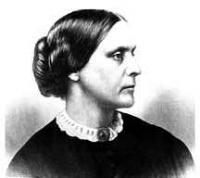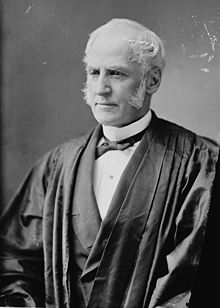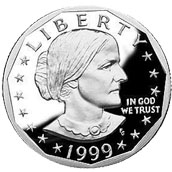
Susan B. Anthony paved the way for what would eventually become the 19th Amendment to the constitution. She was human-rights activist and was heavily involved in the woman’s suffrage movement. Very outspoken and a true leader, Susan was a champion of women’s right to vote, even though she was harshly ridiculed. She serves as a great example today of someone who believed in a cause enough to fight for it.
Upbringing
Susan Brownell Anthony was born on February 15, 1820, to Daniel Anthony and Lucy Read. She was the second of eight children, and grew up in West Grove, near Adams, Massachusetts. Daniel was a cotton manufacturer and an abolitionist, a stern and somewhat strict parent. Nevertheless, he was a man with an open mind. He actively avoided purchasing cotton that had been produced as a result of slave labor. The family were Quakers, who followed the more liberal branch called the “Hicksite Friends.”
In short, the Quakers broke off into two branches. The more orthodox of the two believed that the Bible should be considered the leading authority. The more liberal branch believed that the “Inner Light,” or the source of personal guidance with which all humans are born, was more important, and that it would never lead a person to do anything inconsistent with the teachings of the Bible. As such, Daniel did not allow toys or games in the home, seeing them as distractions from the ‘Inner Light’. He guided his children to become self-disciplined, possessed of principled convictions, and to believe in their own self-worth. Whether it was the result of Daniel’s methods, or Susan’s own nature, she was a precocious child who, by the age of three, was both reading and writing.
A Home School
When Susan was six, the family moved to Battenville, New York, where Susan went to public school. Unfortunately, Susan was not taught long division because she was a girl. When her father became aware of it, he pulled her out and started a home school so he could oversee and participate in her education. One of the teachers there, Mary Perkins, was instrumental in illustrating to Susan and her sisters a picture of progressive womanhood. In contrast with other teachers of the time, who were mostly men, Perkins taught all her students to read. She also had them memorize poems, and physical exercise was part of her curriculum.
When Susan was 15, she started tutoring neighborhood children, which stirred a bit of controversy. Her family was well off, so there wasn’t a financial need for Susan to work. Furthermore, the prevailing attitude was that it was improper for women to work, as their place was in the home. Daniel, however, thought women should be able to support themselves. More importantly, he felt that everyone should work toward being useful, and Susan was doing just that.
In and Out of Seminary
When she was 17, Susan was sent to Deborah Moulson’s Female Seminary, near Philadelphia, in Pennsylvania. There she studied mathematics (arithmetic, algebra and bookkeeping), literature, chemistry, philosophy, physiology, and astronomy. She excelled in her studies. The only thing that gave her difficulty was her crossed eye, which made it difficult to read aloud in class. She felt very self-conscious about it, and those feelings were compounded by the fact that Miss Moulson was quite demanding and critical of Susan. Moulson explained that she had greater demands of Susan than her sister, because she saw Susan as capable of more. She always demanded that her students work to the best of their abilities.
How her studies there would have progressed is unknown, because in April of 1838, Daniel was forced to pull his two daughters out of the boarding school. The economic downturn had forced Daniel Anthony out of business, and the family sold their possessions to buy food. The family moved to what is now Center Falls, New York. Susan began teaching at Eunice Kenyon’s Friends’ Seminary, in an effort to help pay off her father’s debts. In 1846, she taught at Canajoharie Academy, and she eventually became headmistress of the Female Department. She earned $110 per year, one fourth of the wages of male teachers with the same duties. By the age of 29, Susan had moved back in with her family, who by that point had a farm in Rochester, New York.
The Temperance Movement
During that time, Susan became involved in the Temperance Movement, which attempted to curtail or abolish the consumption of alcohol. At the time, the reasons for the movement centered around issues of domestic violence associated with alcohol abuse. For Susan, a driving force had been her observance of alcohol abuse by Quaker preachers. Eventually, she would distance herself from organized religion entirely. She once said, “I distrust those people who know so well what God wants them to do, because I notice it always coincides with their own desires.”
Though she was very self-conscious about public speaking, she did begin giving speeches regarding alcohol abuse, which set the stage for her later public life. In 1851, Susan was introduced to Elizabeth Cady Stanton. It would mark the beginning of a life-long relationship between the two women. Elizabeth, who was married and had children, did more of the background work for the Temperance Movement, writing and drafting ideas, while Susan, who was unmarried, traveled and spoke more often, thus bearing the brunt of the public’s animosity.

Equality in Education
Susan first focused on equality in teaching and education. In 1856, at the state teachers’ convention, she argued for the inclusion of women in teaching, better pay, and the participation of women on committees. She argued for coeducation at conventions in New York and Massachusetts in 1859. She thought that all schools, colleges and universities should be open to women and ex-slaves, and she made efforts to gain opportunities for the children of ex-slaves to attend public schools.
By the 1890’s, she had raised $50,000 in pledges to ensure the admittance of women into the University of Rochester, and even put into the pot the cash value of her own life insurance policy. In doing so, the university was forced to admit women for the first time in 1900. At first, Susan advocated for equal rights for both women and African Americans. In fact, she attempted to bring the two movements together. She was associated with figures such as Abby Kelley and Frederick Douglass, and at the Ninth National Women’s Rights Convention, on May 12, 1859, she is quoted as asking, “Where, under our Declaration of Independence, does the Saxon man get his power to deprive all women and Negroes of their inalienable rights?”
‘The Revolution’ Journal
On January 1, 1869, Susan and Elizabeth began publishing a weekly journal called The Revolution. This journal was devoted to promoting the rights of women and African Americans. George Francis Train, and independently wealthy and eccentric man, backed the publication financially. The motto was, “The true republic-men, their rights and nothing more, women, their rights and nothing less”. Among the discussions in the publication were those of suffrage, equal pay for equal work, and more liberal divorce laws. It advocated an eight-hour day, and promoted a policy of purchasing American-made goods.
In a strange twist, support by The Equal Rights Association for the 15th Amendment to the Constitution, which guarantees the right to vote regardless of race, color, or previous condition of servitude, caused Susan to break ranks with the supporters of equal rights for African Americans. While the legislation granted suffrage to black men, it did nothing for women, black or white. It became clear to Anthony that her focus needed to be on the rights of women. She continued her work in the Temperance Movement, and continued to impress upon people that, without the right to vote, women would continue to be unable to influence public affairs.

The Right To Vote
On November 1 1872, Susan B. Anthony, along with a group of women she had organized, entered a barbershop in order to register to vote in the upcoming Presidential election. According to her argument, women were already constitutionally guaranteed the right to vote under the Fourteenth Amendment, which said that “all persons born and naturalized in the United states…are citizens…” The women demanded that election inspectors register them to vote, and when the logic of Susan’s arguments did not sway them, she said, “If you refuse us our rights as citizens, I will bring charges against you in Criminal Court and I will sue each of you personally for large, exemplary damages!”
The inspectors consulted with each other, and decided that by registering the women to vote, they would be taking themselves out of the legal battle, thus placing the entire offense on the shoulders of the women. The community expressed outrage in newspaper editorials, both at the audacity of the women, and at the capitulation of the election inspectors who registered them.
On November 5, Anthony and fourteen other women cast their ballots. She voted a straight Republican ticket, based upon the party’s promise to respectfully consider the demands of women. Susan was arrested on November 18, following a complaint filed by Rochester salt manufacturer Sylvester Lewis, who claimed Susan cast an illegal ballot. Though all of the women who voted were arrested, she was the only one brought to trial.
Susan Anthony vs. Judge Hunt
As the trail neared its end, the presiding judge, Ward Hunt drew from his pocket a previously drafted statement. He read, “The Fourteenth Amendment gives no right to a woman to vote, and the voting by Miss Anthony was in violation of the law…Assuming that Miss Anthony believed she had a right to vote, that fact constitutes no defense if in truth she had not the right. She voluntarily gave a vote, which was illegal, and thus is subject to the penalty of the law. Upon this evidence, I suppose there is no question for the jury and that the jury should be directed to find a verdict of guilty.”
In making this move, the judge took away the opportunity find Anthony innocent. One juror was quoted as saying, “Could I have spoken, I should have answered ‘not guilty,’ and the men in the jury box would have sustained me”. When it came time for sentencing, an exchange between Susan and Judge Hunt ensued. She attempted to argue that her rights were being trampled. Hunt would hear nothing of it, and sentenced her to pay a $100 fine and court costs. In response, she openly refused to pay the fine, though she saw the court costs as honest debt. Judge Hunt cunningly declined to arrest her, knowing that by doing so, she would be unable to appeal his verdict.

The Aftermath
Ironically, the trial afforded Susan a measure of notoriety, giving her a much wider reach than she had previously had. She continued in her work to obtain equal rights for women until the end of her life. In 1890, she orchestrated the merger between the National Women’s Suffrage Association and the American Woman Suffrage Association. Anthony believed that a more moderate approach had a better chance of success, which caused tension between herself and Elizabeth. She felt it more important to unite the various suffrage movements if they were to see success.
In a letter to Elizabeth, she wrote, “We number over 10,000 women and each one has opinions…we can only hold them together to work for the ballot by letting alone their whims and prejudices on other subjects.” Though Elizabeth’s more radical views were relegated by the merger, Susan successfully pressed for Elizabeth to be elected the first NAWSA president. The pair continued working together toward a common goal well into their later years.

Remembering
Susan B. Anthony died at her Rochester, New York home, on March 13, 1906. She did not live to see the ratification of the Nineteenth Amendment, giving women the right to vote. She was the first woman to appear on a U.S. coin, the Susan B. Anthony dollar, which was minted for four years, 1979, 1980, 1981, and 1999. Susan was a champion of women’s right to vote, and she will always be remembered as someone who stood up for their beliefs and ideals, far past the point of controversy.